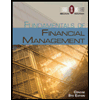
1.
Introduction:
Total amount of assets invested in A and G in the current year.
2.
Introduction: The return on assets is a financial ratio which states that how profitably a company has employed its assets. In other words, how the company has utilized its assets to generate income.
The return on assets of the company for the current year of A and G.
3.
Introduction: Expenses are incurred to generate revenues and thus, form an essential part of the income statement.
Requirement 3
The total expenses of the A and G company for the current year.
4.
Introduction: Comparison between similar companies in the same industry is crucial to the assessment of the company’s performance. A company’s financial ratios, when compared with the industry data, can reveal lots of valuable information which the financial statements can not reveal.
Requirement 4
The A company’s and G company’s return on assets for the current year is better or worse than the competitor’s average return.
5.
Introduction: Investors greatly rely on financial or accounting ratios along with the financial statements before making decisions for investing in a particular company. The limitations of financial statements can be removed by incorporating the ratios into the analysis and making investment decisions.
Requirement 5
Whether one should invest in G or A company based on return on assets.
Want to see the full answer?
Check out a sample textbook solution
Chapter 1 Solutions
FINANCIAL + MANAGERIAL ACCOUNTING W/CONN
- In 2022, North Shore Community College had a total student body that was 5% more than in 2021, which was 5% more than in 2020. The enrollment in 2022 was 4,200. How many students attended the college in 2021? How many students attended the college in 2020?arrow_forwardWhen iam uploading it getting blurr comment i will write values. Don't answer with incorrect dataarrow_forwardSolve correctly if image is blurry comment..arrow_forward
- If data is not clear please commentarrow_forwardPlease don't use AI And give correct answer .arrow_forwardLouisa Pharmaceutical Company is a maker of drugs for high blood pressure and uses a process costing system. The following information pertains to the final department of Goodheart's blockbuster drug called Mintia. Beginning work-in-process (40% completed) 1,025 units Transferred-in 4,900 units Normal spoilage 445 units Abnormal spoilage 245 units Good units transferred out 4,500 units Ending work-in-process (1/3 completed) 735 units Conversion costs in beginning inventory $ 3,250 Current conversion costs $ 7,800 Louisa calculates separate costs of spoilage by computing both normal and abnormal spoiled units. Normal spoilage costs are reallocated to good units and abnormal spoilage costs are charged as a loss. The units of Mintia that are spoiled are the result of defects not discovered before inspection of finished units. Materials are added at the beginning of the process. Using the weighted-average method, answer the following question: What are the…arrow_forward
- General accountingarrow_forwardFinancial accounting questionarrow_forwardOn November 30, Sullivan Enterprises had Accounts Receivable of $145,600. During the month of December, the company received total payments of $175,000 from credit customers. The Accounts Receivable on December 31 was $98,200. What was the number of credit sales during December?arrow_forward
 Intermediate Financial Management (MindTap Course...FinanceISBN:9781337395083Author:Eugene F. Brigham, Phillip R. DavesPublisher:Cengage Learning
Intermediate Financial Management (MindTap Course...FinanceISBN:9781337395083Author:Eugene F. Brigham, Phillip R. DavesPublisher:Cengage Learning
 Fundamentals of Financial Management, Concise Edi...FinanceISBN:9781285065137Author:Eugene F. Brigham, Joel F. HoustonPublisher:Cengage Learning
Fundamentals of Financial Management, Concise Edi...FinanceISBN:9781285065137Author:Eugene F. Brigham, Joel F. HoustonPublisher:Cengage Learning




